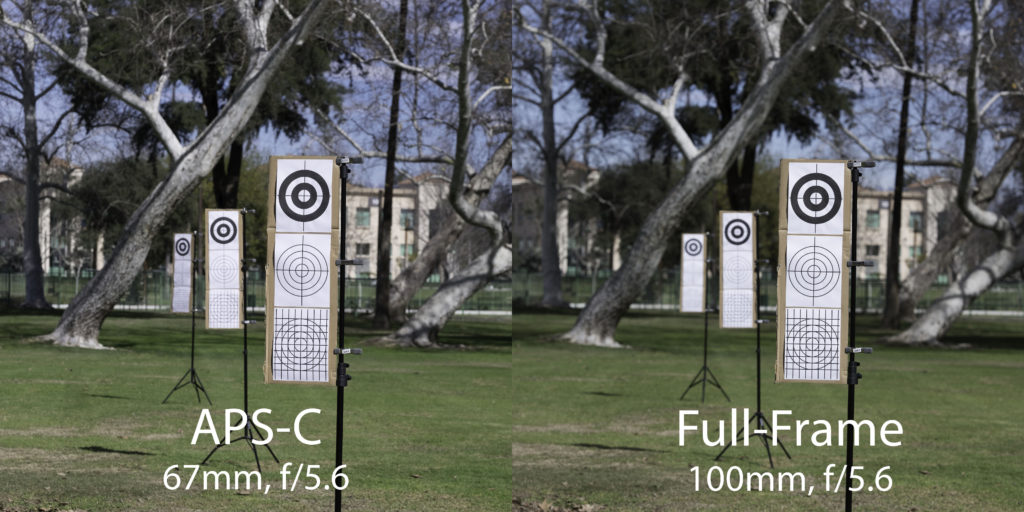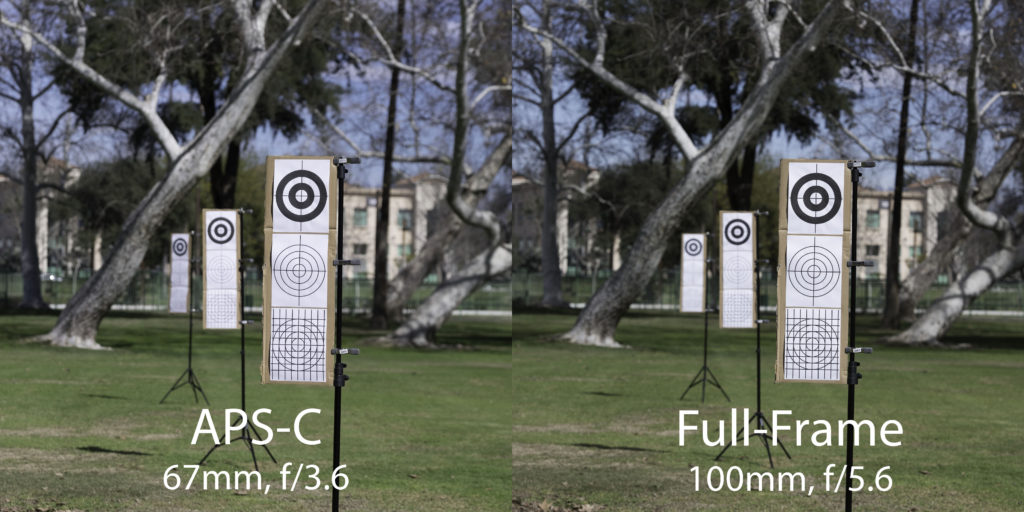I had to use a very large depth-of-field for the landscape scene shown in the image above to render the very close foreground objects and the distant clouds with acceptable sharpness.
Introduction
Depth-of-field is a concept that causes a great deal of confusion for the vast majority of photographers, and as a general rule it is the most difficult concept in photography. Most amateur photographers never master it, and for the most part even professional photographers have not mastered it with the rigor needed to explain it. Yet it is also one of the most important concepts in photography, and next to exposure it is arguably one of the most powerful tools in the photographer’s arsenal.
Simply put, “depth-of-field” is defined as the range in a photograph, from near to far, that appears to be in focus. The key word here is “appears,” since in reality the range of the photograph that is in perfect focus is very small. Figure 1 shows a simple camera lens:

Figure 1
Notice how the lens focuses at a fixed distance called the focal plane. Therefore, everything forward or aft of the focal plane is out of focus. The key to depth of field is the human eye’s finite ability to see fine detail, known as it’s resolving power. Thus, there will be a range both in front of and behind the focal plane where the image could be projected, and the eye would still perceive it as being sharp.
Circle of Confusion (COF)
This is a group of photographers sitting in a circle discussing depth of field. Well, not exactly, although I suppose that could be valid in some instances.
To completely understand depth-of-field, it is first necessary to understand the circle-of-confusion (COF). As was stated in the introduction, the human eye only has a finite ability to see fine detail. It is generally accepted that at a normal reading distance, the smallest object that the human eye can see is 1/16mm. The photographic industry long ago decided that this is way too small a parameter, and instead has settled on 1/6mm as the smallest point clearly discernable to the human eye under normal circumstances. That translates to 0.1667mm in decimal format. Therefore, the smallest allowable detail must be 0.1667mm on the final print in order to be rendered by the human eye as being in focus. Keep that number (and that concept) tucked away in your memory.
So then, what exactly is the circle-of-confusion? Have a look at Figure 2. The circle-of-confusion represents the physical size the out-of-focus image is on the recording medium. The more out of focus the image, the larger the circle-of-confusion. That’s all there is to it.
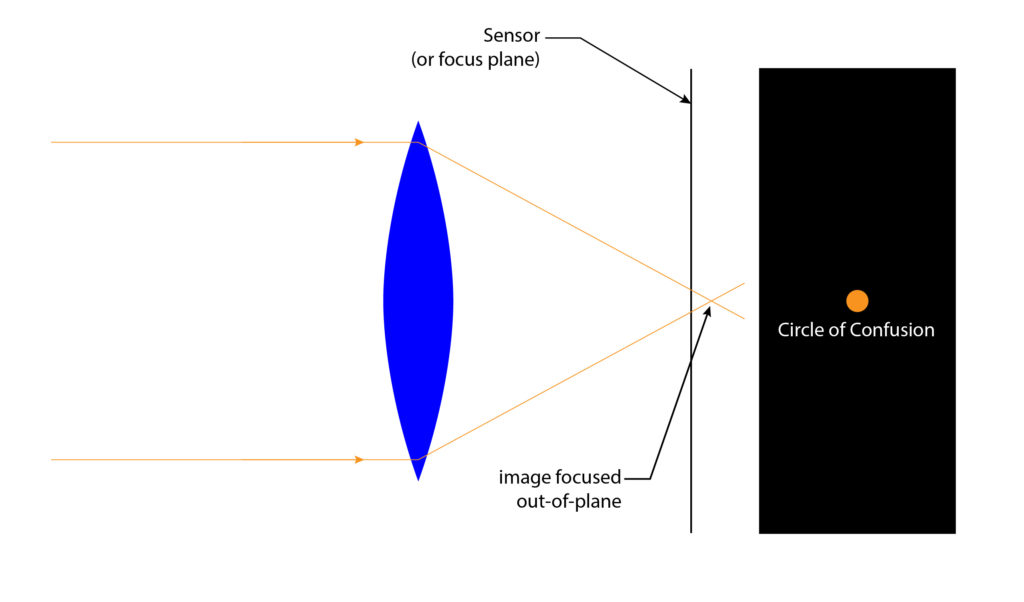
Figure 2
Next consider that the image projected onto the recording medium (whether film or a digital sensor) will be enlarged when the final print is made. The photographic industry typically considers that for the purposes of calculating depth-of-field, an image will be enlarged 5X from negative to print (don’t ask me how they came up with this arbitrary number). What that means is that if on the final print the largest allowable detail is 0.1667mm (remember that number?), then the largest allowable detail on the recording medium must be 0.1667mm/5 = 0.0333mm (see Figure 3). So the formula for calculating the COF is then:
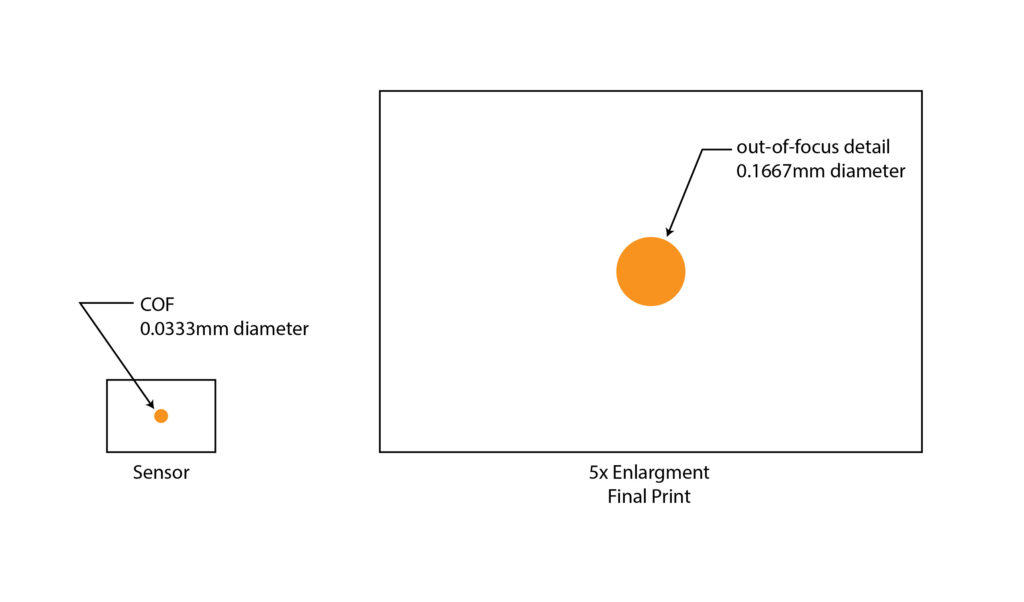
Figure 3
Generally speaking, 0.0333mm is approximately the number used by the photographic industry when making depth-of-field calculations. Unfortunately, most camera manufacturers generally don’t publish the precise number they use, but it can be figured out through reverse engineering if the lens has distance scale markings.
In practice though, not all prints are enlarged to exactly 5X. Some prints will be smaller, but many will be larger, in some cased much larger. Enlarging a final print to 16” x 20” or even larger is not uncommon. So how do you handle such a situation? First off, don’t panic. The solution is simple and only involves a few elementary calculations. To demonstrate this, let’s say that you take a picture with your 35mm full-frame camera and want the final print to be 24” x 36” for displaying on your wall. The dimensions of a full-frame digital sensor (equating to a 35mm film negative) are 24mm x 36mm, and the dimensions (in millimeters) of the final print are 610mm x 914mm. Therefore, the respective diagonal dimensions are 43.27mm and 1100mm, so that translates to a 1100mm/43.27mm = 25.40X enlargement. So, in this case the required COF then is 0.1667mm/25.40 = 0.0066mm. So the formula for COF in this case is:
It needs be pointed out at that the COF must be calculated for each sensor and print size combination, but keep in mind that only the denominator in the equation changes. The numerator is a constant and will always equal 0.1667mm (well, that is not technically 100% correct, as I will explain below, but don’t worry about it).
As you can see by now, medium and large format lenses require a lot less stringent COF than lenses for either 35 mm or APS-C (typical size for DSLR) film or digital sensors. This is because the recording medium is considerably larger, and therefore the final print will not be enlarged nearly as much.
To sum it up then, the COF is the maximum size detail allowed on the recording medium in order to provide a sharp image which appears to be in focus when the final print is enlarged. Simply put, the size of the recording medium and the final print size determine the required COF. I realize this concept is not an easy one, and you may need to re-read this section several times to get a good grasp of it. Trust me, its worth it.
I don’t mean to add any extra confusion, but remember how I told you that 0.1667mm in the numerator of the COF equation can sometimes change? We are dealing with the eye’s ability to discern detail, and no two people are the same in this regard (or any other for that matter). Of course, the viewing distance in front of the image will be a factor as well. Take for example a billboard that looks sharp when viewed from across the street. You can even see the fine detail in the model’s hair or even her individual eyelashes, but when viewed up close, the dots used in printing appear the size of golf balls. Therefore, the farther away we are when we view the print, the larger the numerator in the COF equation. With the exception of a few specialized cases however, using 0.1667 mm will produce an acceptable COF. So don’t lose too much sleep worrying about it.
Now you might be thinking, what on earth does all this circle of confusion mumbo jumbo mean? How am I supposed to use the COF to calculate depth-of-field? Hold tight, we will examine these things later. For now, let’s look at two more definitions.
Depth-of-Field
It is time for a formal definition of depth-of-field.
Definition: The area in front of and behind a focused subject that appears to be sharp (see Figure 4).

Figure 4
Now that we understand what the COF is, and that it is a human imposed parameter, we can examine what depth-of-field really means. This is strictly an optical phenomenon. Once the COF has been applied, no discretion is allowed.
Knowing what the COF means, the term depth-of-field is defined as the range in a photograph that appears to be in focus within the limits of the applied COF. Therefore, it is impossible to define depth of field without the COF number.
One more very important point concerning depth of field: it ranges from 1/3 the distance behind the focused subject to 2/3 the distance in front of the focused subject. Simply put, that means that you have twice as much distance in front of the focused subject as you do behind the focused subject. This is a very important concept to understand, especially if you are trying to maximize the depth-of-field or use selective focus.
Hyperfocal Distance
Definition: The closest point in focus at a given aperture, at which infinity falls within the depth-of-field. This allows you to effectively maximize the depth-of-field and obtain the greatest focus.
Back in the ice age when nearly every 35mm camera lens had depth-of-field scales printed on them, calculating the hyperfocal distance was a relatively easy task. With the more recent disappearance of depth-of-field scales on 35mm lenses, most photographers have either forgotten what hyperfocal distance is or have never learned it in the first place. This is a terrible shame, because it is extremely important for landscape photographers. However, not all is lost. There are equations for manually calculating the hyperfocal distance, or alternatively, there are several very good tools online as well as applications for smart phones that will perform the calculations for you. Simply input the focal length, f-stop (otherwise known as the aperture), sensor size, the COF (not all apps allow manual COF input), and the program will tell you at what distance to focus to obtain the hyperfocal distance. One very good website for this is dofmaster.com.
Some people may wonder if the COF formula will change depending on whether the camera is a DSLR or mirrless. In short, the answer is no. The fact is, it makes no difference, as there are only four parameters that matter in calculating depth-of-field or hyperfocal distance: (1) sensor size, (2) focal length, (3) aperture, and (4) COF.
If you are lucky enough to have a lens that has depth-of-field marks printed on it, then the hyperfocal distance can be set on the lens itself. The procedure is as follows: align the infinity symbol with the depth-of-field mark for the aperture you are using. The lens is then set at its hyperfocal distance for that aperture. Also, the other pair of depth-of-field marks for the aperture you are using will tell you the closest distance that is in focus. For example, in Figure 5 below, everything from 0.5m to infinity will be in focus when the lens is set at f/16. It can also be seen that for this lens (a Fujifilm 14mm f/2.8) that the focus point for the hyperfocal distance at f/16 is about 0.9m. Note: I believe that Fuji uses a circle of confusion that is way too large. In my calculations, the hyperforcal distance should be much closer to 0.25m.

Figure 5
One limitation, however, with the depth-of-field marks printed on the lens is that you are limited to the manufacture’s COF. If you are planning on making a large print or are extra picky about your focus, you can always use the depth-of-field marks for the next larger aperture. For example, if you are shooting at f/16, use the depth of field marks for f/11.

Figure 6
I had very close foreground objects in the image in Figure 6 above, and using the hyperfocal distance was essential to get everything in acceptable focus.
Depth-of-Field Equations
Ok, so now you know the meanings of circle of confusion and depth-of-field. Now you may be itching to know just how to use the COF number to manually calculate the depth-of-field. Well, here’s how. This does involve a little math, but don’t worry about that, just try to follow me for now. Equation 1 is the formula for calculating the hyperfocal distance for any given aperture and focal length.
Equation 1
where:
H = the hyperfocal distance
f = focal length in mm
c = circle of confusion in mm
N = f-number, as calculated below
N is calculated as , where i = 1, 2, 3,… for f/1.4, f/2, f/2.8, …
Two additional equations given below can be used to calculate the near and far distances of acceptable sharpness, respectively.
Equation 2
Equation 3
Where Dn and Df are the near and far distances for acceptable sharpness, respectively, and s is the focus distance (which can be set to any arbitrary value, but of course will equal the hyperfocal distance when you are using the hyperfocal distance). Also note that as the subject distance approaches the hyperfocal distance, the denominator in Equation 3 approaches 0. That makes sense, because as we move the focus point closer to the hyperfocal distance, infinity should come into focus (this concept will be clear to those who have studied calculus).
Like I said above, you really don’t need to worry too much about the math as there are free apps out there that will perform the calculations for you. I have two degrees in engineering and not even I perform these calculations manually in the field, I am more than happy to let the app on my smart phone do that for me. I am just giving this to you so that you will know what the app is doing behind the scenes, and that it really is in fact a true science and not a black art.
Aperture and Depth-of-Field
Definition: The aperture is related to the size of the lens’ diaphragm opening. The diaphragm opens and closes to control how much light can reach the sensor, just like pupils in your eyes are larger in a dark room than they are when you are out in bright sunlight. The larger the diaphragm, the more light is allowed to pass through the lens and reach the recording medium (see Figure 7). However, another consequence of changing the size of the diaphragm is that the depth-of-field changes, too. Decrease the aperture (using a larger f-stop) and you will get a greater depth-of-field.
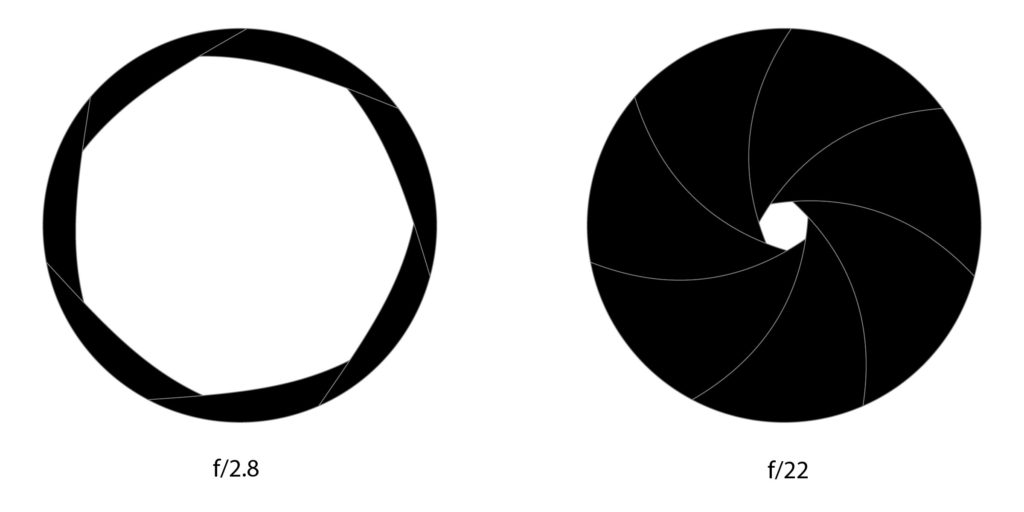
Figure 7
However, this preceding definition assumes that all other variables are equal (sensor size and focal length). This is where things can get a little complicated, but I will let you in on a secret. That is, there is only one variable that determines depth-of-field, no matter what focal length, sensor size, camera format, lens, etc. is used. That one variable is the physical size of the diaphragm, and it is an inverse relationship: the larger the size, the smaller the depth-of-field. No more, no less. You can verify this mathematically using the depth of field equations provided above if you really have a desire to.
Before going any further, I need to explain just exactly what the aperture and f-stop are. The f-stop is a number used to represent how much light can pass through the diaphragm and reach the sensor. The f-stop is shown as f/number. For example, an f/2.8 is how you would say that your lens is set to an aperture of 2.8. So, in short, f/2.8 tells us how much light can pass through the diaphragm. An aperture of f/2.8 allows exactly twice as much light as an aperture of f/4. But why do we express the aperture value this way, and what does it mean?
The f-stop is a fraction expressed as follows:
Equation 4
This means is that for a focal length of 100mm at f/2.8, the diameter of the diaphragm is 100mm/2.8 = 35.7mm. At f/4, it would be 100mm/4 = 25m. From geometry, we know that the area of a circle is A = πr2. Doing the calculations gives the area of the diaphragm opening at f/2.8 at 1000mm2, at f/4 it is 500mm2. That means that exactly twice as much light can pass through the diaphragm at f/2.8 as at f/4.
Now that we know that the f-stop is related to the focal length, you can see that the diaphragm will be different for different focal lengths, even when the same f-stop is used. This is because a larger diaphragm is required at longer focal lengths to allow the same amount of light to reach the sensor. For example, on a 24mm lens set to f/2.8, the diaphragm has a diameter of 8.57mm, whereas on a 200mm lens set to f/2.8, the diaphragm is a whopping 71.4mm! But the total amount of light reaching the sensor is the same in both cases.
All the content in this section may be summed up into two important points:
- Depth-of-field is determined by the physical size of the diaphragm opening (not to be confused with f-stop), and is independent of all other variables. You will have the same range of objects in focus regardless of focal length or sensor size. (Of course, this does assume that you have set the same focus distance).
- The f-stop dictates how much light can reach the sensor per unit area, and is related to the focal length and the diaphragm opening size. The same f-stop will allow the same amount of light per unit area to reach the sensor no matter the focal length. However, the longer the focal length, the larger the diaphragm opening will be for any given f-stop. The consequence of this is that with longer the focal lengths, there will be less depth-of-field with any given aperture value (or f-stop).
Understanding these concepts gives us insight into why wide-angle lenses give us more depth-of-field. The shorter the focal length, the smaller the diaphragm needs to be to let the same amount of light per unit area pass through the lens and reach the sensor. Since the diaphragm is smaller, the depth-of-field will be larger.
This also explains the reason why smaller format cameras, such as APS-C and Micro Four Thirds, will give a greater depth-of-field than a full-frame for the same f-stop and equivalent focal length (meaning they give the same field-of-view). For example, a 12mm lens mounted to a Micro Four Thirds will give the same field of view as a 24mm lens mounted to a full-frame camera. The depth-of-field, however, will be greater on the Micro Four Thirds camera, assuming they are both set at the same f-stop (or aperture).
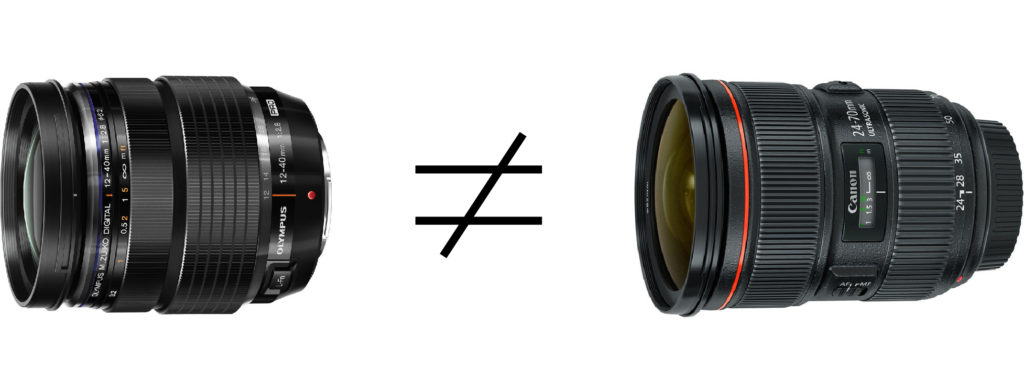
Figure 8
Shown in Figure 8 is an Olympus 12-40mm f/2.8 for the Micro Four Thirds format, and a Canon 24-70mm f/2.8 for the full-frame format. Both lenses will show approximately the same field-of-view when mounted to their respective camera formats (remember that micro four thirds has a 2x crop factor). Both also have the same maximum f-stop, namely f/2.8 in this case, so both will allow the same amount of light per unit area to reach their sensors, allowing the same shutter speed and ISO to be selected. However, the depth of field will be greater on the Olympus than on the Canon.
The formula to convert the f-stop equivalence from one format to another is very simple:
Equation 5
Therefore, for the lenses in Figure 8 above to truly be equivalent, the Olympus would need to have a minimum f-stop of 2.8/2 = 1.4. But that would only account for the depth of field. Of course, an f-stop of 1.4 would mean either a faster shutter speed or lower ISO would be required. What you can now see is that there is no physical way to make lenses for different formats exactly equivalent. Change one factor, and you must change another factor. (There is such a thing as equivalence between different camera formats, a subject for which I wrote an entire article.)
To illustrate this concept, take a look at the images show below. Figures 9 and 10 show the same scene shot on both APS-C and full-frame cameras. In this case the focal length for both cameras has been set to give the same field-of-view (67mm for the APS-C and 100mm for the full-frame), and both are focused at the same physical distance (the closest target). In Figure 9, both images were shot at f/5.6. Notice how much sharper the background is for the image shot with the APS-C camera.
Figure 9
Now compare that to Figure 10, where the only difference is that the APS-C was now shot at f/3.6 (the equivalent to f/5.6 on full-frame, 5.6/1.5=3.6, rounded to the nearest 1/3 stop of course).
Figure 10
Notice that the images look identical in Figure 10.
This leads to another important question: Is it misleading to label the Olympus as an f/2.8 lens? Unfortunately, there is no simple answer. The f-stop is a physical number derived by a simple equation, just like the focal length. That equation does not change regardless of the format the lens was made for. The f-stop will behave differently between the Olympus and Canon lenses in terms of depth-of-field, but it is still the same f-stop. Remember from the exposure triangle, the f-stop will still have the same effect on required shutter speed and ISO regardless of the format. Sometimes a manufacturer will label the focal length in terms of its full-frame equivalent to assist photographers who were used to that format, but I have never seen the f-stop labeled in its full-frame equivalent. I wish that manufactures would label their lenses according to both their physical f-stop and their full-frame equivalent f-stop for easy comparisons, just like they are so willing to do for the equivalent focal length, but that is just not what they have chosen to do. So for now, we will have to be content calculating the equivalent f-stop ourselves when comparing different camera formats. You could say that this uncovers a fundamental flaw in the old ISO and f-stop naming systems, but I don’t think that this flaw is going away anytime soon. Until then, we must understand the definition of equivalency, which I have written an entire article on if you want to explore the concept further.
The T-stop, and Why I Should Care About It
Up until this point, I have mentioned the fact that the f-stop is what determines how much light passes through the lens and ultimately reaches the sensor. Unfortunately, this is not entirely correct. This is because some light is reflected off the front of the lens elements, while still some light is absorbed by the lens elements themselves. What I said about the f-stop and its relationship to depth-of-field is correct, and I did not want to bring any more confusion to the table. The t-stop has no relevance to depth-of-field and so I am including that discussion in a separate article. The t-stop is a numerical value just like the f-stop, except that it tells us the true amount of light that actually reaches the sensor, which will always be less than the f-stop. Effectively, the t-stop is the corrected f-stop for the amount of light reaching the sensor.
To explore the t-stop further, I encourage you to read my article here.
Wrapping It Up
If you are sill with me, then congratulations! I know that this is one of the most difficult subjects in photography to understand, let alone master. To sum up some of the concepts we have learned:
- Focal Plane
This is the precise distance the image is focused at (see Figure 2), and this is where the sensor is located. Everything in front of or behind this point will be out of focus. The further you move away from the focal plane the more out of focus subjects will become.
- Circle of Confusion (COF)
The maximum size a detail can be on the digital sensor that will subsequently be enlarged on the print. The larger the print, the smaller the COF. The COF is a number used in a mathematical formula to calculate the depth of field.
- Hyperfocal Distance
The closest point in focus at a given aperture, at which infinity falls within the depth-of-field.
- Aperture
This is a number that determines how much light passes through the lens and reaches the sensor. It is dependent on the focal length of the lens. The smaller the f-stop, the larger the depth-of-field for a given focal length.
- Diaphragm Diameter
The larger the diameter of the diaphragm (or aperture), the smaller your depth-of-field. Depth-of-field is determined entirely by the diameter of the diaphragm, and is independent of the focal length, or even the sensor size.
So there you have it. While this article is not meant to be a 100% in-depth study on the subject, I hope that it does give you a better understanding and perhaps clears some things up. You now have a basic understanding of what depth-of-field is, and how to use hyperfocal distance to maximize it. Don’t be ashamed if you need to re-read this article several times, nor do you need to feel ashamed if you need to refer back to it. Truth be told, I had to refer to some of my photography books too when I wrote this article, just to be sure I was getting it right. Remember, practice what you have learned, and you will become the master.
Resources
There are some fantastic resources for calculating the depth-of-field and hyperfocal distance.
This is one of my favorite websites for calculating the hyperfocal distance. They also have an app for iPhone and iPad. At the time of this writing, an Android version is on its way.
Photo Pills
This is a fantastic app for smartphones and tablets that contains a myriad of tools for the photographer, including a hyperfocal calculator. This is by far my favorite photography app, and is available for both iOS and Android.
Photo Tools
This is an app for Android phones that, like Photo Pills, has a myriad of tools for the photographer.



